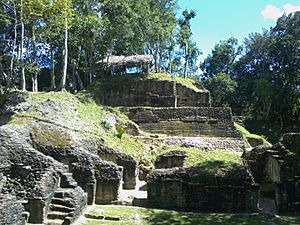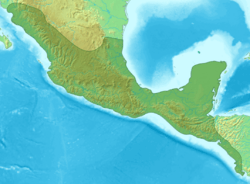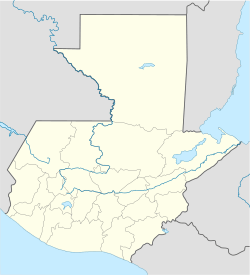Naranjo facts for kids

View of Naranjo
|
|
| Alternative name | Wak Kab'nal |
|---|---|
| Location | Petén Department, Guatemala |
| Region | Petén Basin |
| Coordinates | 17°08′0.95″N 89°15′43.81″W / 17.1335972°N 89.2621694°W |
| Type | Settlement |
| History | |
| Periods | Middle Preclassic to Early Postclassic |
| Cultures | Maya civilization |
| Site notes | |
| Condition | In ruins |
Naranjo is an ancient Maya city located in the Petén Basin area of Guatemala. It was a busy city for a long time, from around 500 BC to 950 AD. Its most important period was during the Late Classic Period.
Today, Naranjo is part of the Cultural Triangle Yaxha-Nakum-Naranjo National Park. The city was built near the Mopan and Holmul rivers. It is about 50 kilometers (31 miles) east of another famous Maya city, Tikal. Naranjo is also known for its special style of colorful pottery. The name "Naranjo" means "Orange Tree" in Spanish. Its original Maya name was Wak Kab'nal.
Contents
Exploring the Ancient City
The city of Naranjo covered a large area, at least 8 square kilometers (3 square miles). The main city center was about 2.25 square kilometers (0.87 square miles). Archaeologists have found 389 buildings in the central area. There are over 900 more buildings around the city center.
The heart of Naranjo had many important structures. These included:
- Six triadic complexes: These are groups of three buildings, usually a large pyramid with two smaller buildings facing it.
- Two ballcourts: Places where the ancient Maya played a special ballgame.
- Two palace compounds: Large buildings where rulers and important people lived.
- One E-group: A special arrangement of buildings used to track the sun's movements and important dates.
The largest triadic complex in Naranjo is called C-9. Its main pyramid, Structure C-9, is the biggest building at the site. It sits on top of a natural hill with a cave inside. This made it a very sacred place, like a "sacred mountain," for the Maya people.
A special stairway with hieroglyphic carvings was added to Structure B-18 around the 7th century AD. It is believed this stairway was originally from another Maya city called Caracol.
Protecting Naranjo's History
People started studying Naranjo a long time ago. In 1905, Teoberto Maler created the first maps and photos of the site. He was sent by Harvard University. In 1908, Maler dug up the hieroglyphic stairway from Structure B-18. Parts of this stairway are now kept in the British Museum in London. More studies were done in the 1910s by Sylvanus G. Morley and Oliver Ricketson.
Sadly, Naranjo has faced a big problem: looting. By the 1920s, many ancient sculptures had already disappeared. The situation got much worse in the 1960s. Looters would smash large sculptures into pieces to smuggle them out of the country.
To protect the artifacts, the Department of Prehispanic Monuments took 19 stone monuments (called stelae) from Naranjo in 1972-1973. From 1997 to 2001, looters controlled the site. Later, from 2002 to 2004, a project found about 270 tunnels and trenches dug by looters. Archaeologist Vilma Fialko has been very important in this work.
A conservation project started in 2002 to help preserve Naranjo. In 2006, Naranjo was added to the World Monuments Watch, which helps protect important historical sites around the world.
In 2013, a building from about 600 AD was found near Naranjo, in a place called Holmul. It had a huge stucco carving (frieze) showing a ruler and two other figures. This carving was very well preserved. An inscription below it suggests that the building was ordered by Aj Wosal of Naranjo. At that time, Naranjo was under the control of the powerful Kaanul dynasty.
Naranjo's Story
The history of Naranjo had many changes in its rulers and alliances. Ancient texts at the site tell a story about the city being founded by its patron god.
Not much is known about Naranjo before the ruler Ah Wosaaj Chan K'inich, who became king in 546 AD. It's possible that Naranjo was influenced by the powerful city of Tikal before this time. Any monuments from that early period might have been destroyed.
In 546 AD, Naranjo came under the control of Calakmul, a rival city to Tikal. Calakmul's ruler, Tuun Kab Hix, appointed Ah Wosaaj Chan K'inich as Naranjo's ruler. This was a smart move by Calakmul to gain allies against Tikal. Ah Wosaaj improved the city's buildings, like paving a road in July 559 AD, as recorded on Altar 2.
Naranjo faced attacks from the city of Caracol in 626 AD. But Naranjo was retaken by Calakmul in 631 AD. Later, during the rule of K'ahk' Xiiw Chan Chaahk, Naranjo defeated Caracol in a major war. This caused Caracol to have a quiet period. However, by 680 AD, Caracol seemed to have recovered and defeated K'ahk' Xiiw.
In 682 AD, Calakmul sent Lady Six Sky to Naranjo to help bring back its royal family. She was the daughter of the ruler of Dos Pilas. Her arrival is written on Stela 24. Lady Six Sky acted as a ruler, possibly helping her son, K'ahk' Tiliw Chan Chaahk, who became king in 693 AD when he was only five years old.
Between 693 and 698 AD, Naranjo launched many attacks, likely led by Lady Six Sky. They defeated Tikal in 695 AD and Ucanal in 698 AD. K'ahk' Tiliw Chan Chaahk started more attacks in 706 AD, including defeating Yaxha in 710 AD. Lady Six Sky passed away in 741 AD. She is shown on several stone monuments (stelae) at Naranjo.
Naranjo was defeated by Tikal in 744 AD. Its ruler, Yax Mayuy Chan Chaahk, was captured. However, this was not the end of Naranjo's story. Later kings, like Itzamnaaj? K'awiil, fought against Yaxha. In 790 AD, he repaved the road that Ah Wosaaj had built, as recorded on Altar 2.
Naranjo was likely abandoned because of political problems and a serious drought around 810 AD.
Important Rulers of Naranjo
Here are some of the known rulers of Naranjo:
| Name | Ruled | Notes |
|---|---|---|
| Tzik’in Bahlam | Mentioned on Stela 45 | |
| ??? | 475 AD | Known from Stela 41 |
| Naatz Chan Ahk | ||
| K'inich Tajal Chaahk | ||
| Ah Wosaaj Chan K'inich | 546-615 AD | The 35th Ruler, mentioned on Altar 1, Stela 16, 17, 25, 27, 38 |
| ??? | 626 AD | Defeated by Caracol |
| K'uxaj | 631 AD | Defeated by Calakmul |
| K'ahk' Xiiw Chan Chaahk | 644?-680 AD | Won against Caracol early in his rule; later defeated by Caracol |
| Ix Wak Chanjalam Lem? | 682 AD | Also known as Lady Six Sky, Lady of Dos Pilas, shown on Stela 3, 18, 24, 29, 31 |
| K'ahk' Tiliw Chan Chaahk | 693-728 AD | Also called Smoking Squirrel, the 38th Ruler, won against Tikal, mentioned on stela 1, 2, 21, 22, 23, 26, 28, 30 |
| Yax Mayuy Chan Chaahk | 744 AD | Defeated by Tikal and captured |
| K'ahk' Yipiiy Chan Chaahk | 746-748 AD | |
| K'ahk' Ukalaw Chan Chaahk | 755-780 AD | Mentioned on Stela 6, 13, 19, 33, 36 |
| "Bat" K'awiil | ||
| Itzamnaaj? K'awiil | 784-810 AD | Won against Yaxha, mentioned on stela 7, 8, 10, 12, 14, 35 |
| Waxaklaju'n Ubaah K'awiil | 814 AD |
Images for kids
See also
 In Spanish: El Naranjo (Guatemala) para niños
In Spanish: El Naranjo (Guatemala) para niños




